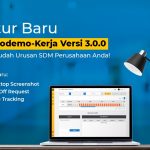HRIS applications are currently the most widely used form of software by Human Resource Departments (HRD). As we know, the collection of employee data plays an important role for any company. That’s why HRIS applications are designed to make it easier for management to comprehensively manage such data all within one secure location without having to search through various different file locations.
Dokodemo-Kerja is currently the best online attendance application in circulation, applying a full range of features used to flexibly increase overall employee productivity.Some of these features include Attendance & Leave Management, Task Organization, as well as Employee performance evaluation: all through just one application.
Manage Employees Easier through the Dokodemo-Kerja HRD Application. Try it now!
In order to better understand what the HRIS application is and what it does, we aim to inform you about the definition of HRIS and go through its main functions.
Table of Contents
What is HRIS (Human Resources Information System)?
HRIS is a system used to collect and store a company’s employee data. HRIS can be used to store, process, and manage a wide variety of such information, ranging from names, addresses, employee IDs, social security, and much more. Overall, HRIS presents a smarter method of storing information into an employee database.
In addition, it is important to know that in general, HRIS systems also have functions that support HR management, such as employee attendance & leave management, performance appraisals, administrative arrangements regarding employee benefits or salaries, and much more. Overall, through HRIS systems, the process of human resource management can be done digitally and effectively.
In using this system, companies utilize cloud-based or on-premise HRIS applications. If the company uses on-premise software, information storage will be based within databases and servers being operated by the company itself. Meanwhile, through the use of cloud-based software, such data will be stored within the HRIS application provider’s data center server.
Read Also: Fundamental Differences between HRIS, HCM, and HRMS Technologies
HRIS System Components
1. Database
HRIS has a database used to store employee information. The HR team can enter the entirety of such stored employee data within the system, being able to access this information from anywhere at any time.
2. Time and labor management
HRIS utilizes a feature that allows employees to enter their own work hours or to leave requests as they see fit. Through these components, the HRIS application can thereby improve the HR department’s ability to track employee timelines and their overall attendance rate.
3. Payroll function
HR can accurately calculate the number of hours worked so as to determine appropriate employee salary payments amounts.
4. Allowances or benefits
HRIS accounts for employee assistance arrangements, such as medical benefits or pension fund investments.
5. Interface for employees
Most HRIS applications provide employees with a level of user access. However, employees are only allowed limited access to databases where they can update their personal information, review pay scales, or apply for leave.
Functions of HRIS (Human Resource Information System)
The Human Resource Department plays a very important role within the company. The HRD team serves in making sure a company’s workforce is of the utmost quality, which entails maintaining a high level of employee productivity, among other roles. In order to fully optimize the overall efficiency of the HR team’s work processes, it is necessary to have the right HRIS application.
A HRIS application can provide various benefits for your company, such as allowing the HR team to optimize their administrative tasks. By doing so, the HR team can potentially focus their attention on more pressing HR tasks.
An advanced HRIS system that effectively monitors the performances and productivity of your employees. WFO or WFH? Manage both and Stay Productive with Dokodemo-Kerja!
An affordable HRIS app that increases productivity. Check it out here!
Of the various HRIS components previously described, here are some of the main functions of the HRIS application:
1. Record function
A HRIS can work as a record system which is able to track any changes related to employee data.
2. Fulfill the completeness of employee data
Most companies will collect and store comprehensive data about their employees. For example, a company most likely stores a variety of contact information about the individual, in the case of an accident, or in regards to taxes, etc. All information will be stored securely through the HRIS application. That is why HRIS is often relied on as an intelligent source of staffing data.
3. Improve the overall efficiency of the HR administration processes
Digitally based methods of management can greatly raise the productivity of your company’s HR team. Because such systems store a variety of data within a single location, the HR team will undoubtedly find it easier to update, track, and manage vast amounts of employee data.
4. The process of analyzing and evaluating employee performance
The HRIS application allows you to analyze and review the overall performance of your employees. Most HRIS applications now have an e-attendance feature that automatically records employee attendance hours so as to gauge each employee’s individual level of discipline. In addition, the HRIS application also provides a variety of useful data that can be used to evaluate and report on an employee’s performance.
5. Self-Service for employees
The HRIS application offers self-service capabilities for its employees. This means that employees can handle various metters independently regarding their data within the company. Examples include the ability to update personal information, view remaining leave quotas, apply for leave, track PTO, and others.
Companies that are able to make good use of the HRIS application will get a strong sense of the benefits of doing so. This software is deliberately designed with various features that work to simplify the human resource management process for better efficiency and effectiveness. If your company is growing and currently has a substantial number of employees, then it is time for you to switch from a manually-based system to a digital one.
Dokodemo-Kerja, as one of the best HRIS software or applications in Indonesia, was built to make a positive contribution to the process of improving employee performance and overall professionalism within the workplace.







